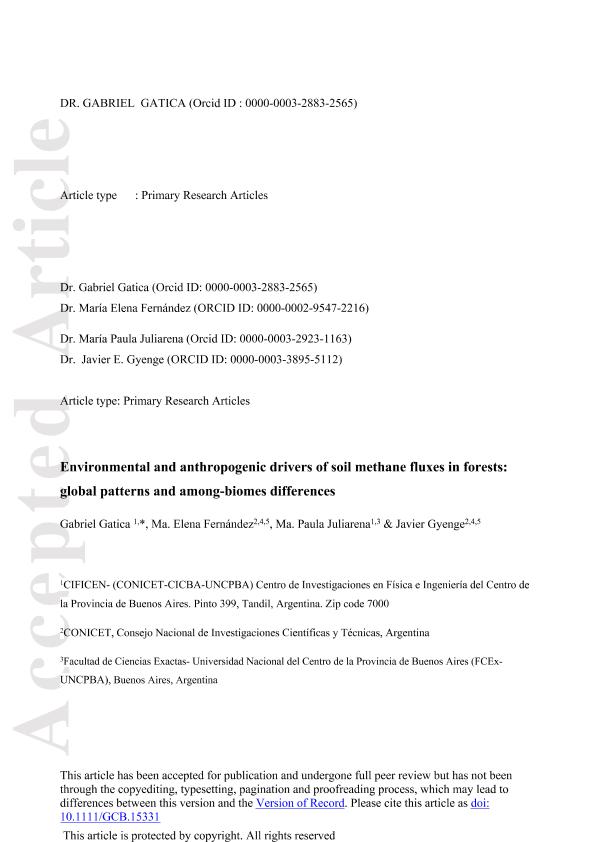Mostrar el registro sencillo del ítem
dc.contributor.author
Gatica, Mario Gabriel

dc.contributor.author
Fernandez, Maria Elena

dc.contributor.author
Juliarena, María Paula

dc.contributor.author
Gyenge, Javier Enrique

dc.date.available
2022-01-05T15:49:02Z
dc.date.issued
2020-09
dc.identifier.citation
Gatica, Mario Gabriel; Fernandez, Maria Elena; Juliarena, María Paula; Gyenge, Javier Enrique; Environmental and anthropogenic drivers of soil methane fluxes in forests: Global patterns and among-biomes difference; Wiley Blackwell Publishing, Inc; Global Change Biology; 26; 11; 9-2020; 6604-6615
dc.identifier.issn
1354-1013
dc.identifier.uri
http://hdl.handle.net/11336/149637
dc.description.abstract
Forest soils are the most important terrestrial sink of atmospheric methane (CH4). Climatic, soil and anthropogenic drivers affect CH4 fluxes, but it is poorly known the relative weight of each driver and whether all drivers have similar effects across forest biomes. We compiled a database of 478 in situ estimations of CH4 fluxes in forest soils from 191 peer-reviewed studies. All forest biomes (boreal, temperate, tropical and subtropical) but savannahs act on average as CH4 sinks, which presented positive fluxes in 65% of the sites. Mixed effects models showed that combined climatic and edaphic variables had the best support, but anthropogenic factors did not have a significant effect on CH4 fluxes at global scale. This model explained only 19% of the variance in soil CH4 flux which decreased with declines in precipitation and increases in temperature, and with increases in soil organic carbon, bulk density and soil acidification. The effects of these drivers were inconsistent across biomes, increasing the model explanation of observed variance to 34% when the drivers have a different slope for each biome. Despite this limited explanatory value which could be related to the use of soil variables calculated at coarse scale (~1 km), our study shows that soil CH4 fluxes in forests are determined by different environmental variables in different biomes. The most sensitive system to all studied drivers were the temperate forests, while boreal forests were insensitive to climatic variables, but highly sensitive to edaphic factors. Subtropical forests and savannahs responded similarly to climatic variables, but differed in their response to soil factors. Our results suggest that the increase in temperature predicted in the framework of climate change would promote CH4 emission (or reduce CH4 sink) in subtropical and savannah forests, have no influence in boreal and temperate forests and promote uptake in tropical forests.
dc.format
application/pdf
dc.language.iso
eng
dc.publisher
Wiley Blackwell Publishing, Inc

dc.rights
info:eu-repo/semantics/openAccess
dc.rights.uri
https://creativecommons.org/licenses/by-nc-sa/2.5/ar/
dc.subject
CH4 UPTAKE
dc.subject
CH4 EMISSION
dc.subject
STATIC CHAMBER
dc.subject
GLOBAL CHANGE
dc.subject
GREENHOUSE GASES (GHG)
dc.subject
NATIVE FOREST
dc.subject.classification
Otras Ciencias de la Tierra y relacionadas con el Medio Ambiente

dc.subject.classification
Ciencias de la Tierra y relacionadas con el Medio Ambiente

dc.subject.classification
CIENCIAS NATURALES Y EXACTAS

dc.title
Environmental and anthropogenic drivers of soil methane fluxes in forests: Global patterns and among-biomes difference
dc.type
info:eu-repo/semantics/article
dc.type
info:ar-repo/semantics/artículo
dc.type
info:eu-repo/semantics/publishedVersion
dc.date.updated
2021-09-06T18:22:35Z
dc.journal.volume
26
dc.journal.number
11
dc.journal.pagination
6604-6615
dc.journal.pais
Reino Unido

dc.journal.ciudad
Londres
dc.description.fil
Fil: Gatica, Mario Gabriel. Universidad Nacional del Centro de la Provincia de Buenos Aires. Centro de Investigaciones en Física e Ingeniería del Centro de la Provincia de Buenos Aires. - Consejo Nacional de Investigaciones Científicas y Técnicas. Centro Científico Tecnológico Conicet - Tandil. Centro de Investigaciones en Física e Ingeniería del Centro de la Provincia de Buenos Aires. - Provincia de Buenos Aires. Gobernación. Comisión de Investigaciones Científicas. Centro de Investigaciones en Física e Ingeniería del Centro de la Provincia de Buenos Aires; Argentina
dc.description.fil
Fil: Fernandez, Maria Elena. Instituto Nacional de Tecnología Agropecuaria. Centro Regional Buenos Aires Sur. Estación Experimental Agropecuaria Balcarce; Argentina
dc.description.fil
Fil: Juliarena, María Paula. Universidad Nacional del Centro de la Provincia de Buenos Aires. Centro de Investigaciones en Física e Ingeniería del Centro de la Provincia de Buenos Aires. - Consejo Nacional de Investigaciones Científicas y Técnicas. Centro Científico Tecnológico Conicet - Tandil. Centro de Investigaciones en Física e Ingeniería del Centro de la Provincia de Buenos Aires. - Provincia de Buenos Aires. Gobernación. Comisión de Investigaciones Científicas. Centro de Investigaciones en Física e Ingeniería del Centro de la Provincia de Buenos Aires; Argentina
dc.description.fil
Fil: Gyenge, Javier Enrique. Consejo Nacional de Investigaciones Cientificas y Tecnicas. Centro Cientifico Tecnologico Conicet - Mar del Plata. Instituto de Innovación Para la Producción Agropecuaria y El Desarrollo Sostenible. - Instituto Nacional de Tecnologia Agropecuaria. Centro Regional Buenos Aires Sur. Estacion Experimental Agropecuaria Balcarce. Instituto de Innovación Para la Producción Agropecuaria y El Desarrollo Sostenible.; Argentina
dc.journal.title
Global Change Biology

dc.relation.alternativeid
info:eu-repo/semantics/altIdentifier/url/https://onlinelibrary.wiley.com/doi/abs/10.1111/gcb.15331
dc.relation.alternativeid
info:eu-repo/semantics/altIdentifier/doi/http://dx.doi.org/10.1111/gcb.15331
Archivos asociados
